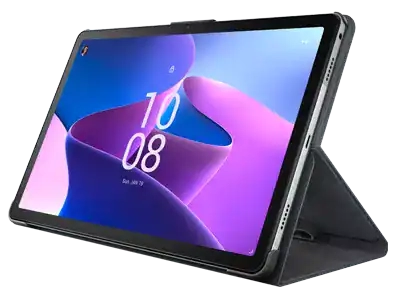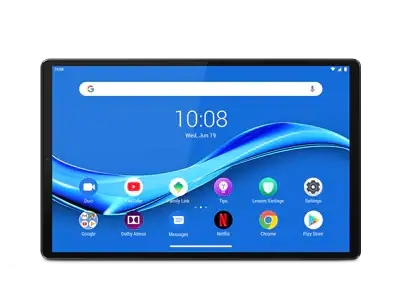What is an IPS Display?
IPS displays are highly popular for their eye-catching color and wide viewing angles. In fact, Lenovo now offers more laptops, tablets and monitors based on In Plane Switching or IPS display technology than with the earlier TN (Twisted Nematic) construction – although TN models are still prized by some users, such as hyper-competitive PC gamers.
So, what does an IPS display really deliver? Which laptop and monitor buyers are most likely to benefit from IPS technology? And why do some users still prefer older-style TN displays? Read on for answers to these and other questions.
IPS vs. TN displays: What’s the difference?
IPS and TN are different kinds of TFT LCDs (Thin Film Transistor Liquid Crystal Displays). At the simplest level, LCDs rely on the light modulating properties of energized liquid crystals – along with coordinated light filtering polarizers (both behind and in front of the crystals) -- to control what appears on the screen. By applying voltage to each crystal (or not), light is made to pass through the polarizers (or not). When these changes are managed at microsecond intervals, you get smooth moving images.
LENOVO OFFERS DOZENS OF LAPTOPS WITH IPS DISPLAYS:
TN and IPS displays differ in how their light-influencing polarizer layers are aligned. If this sounds too technical, just know that when polarizers are aligned similarly, light can pass through, but when they’re put in different orientations, light is blocked. And when you place liquid crystal molecules between the polarizer layers and apply voltage, interesting things happen:
- TN polarizers are aligned perpendicular to each other. Without voltage, the liquid crystal molecules naturally “twist” the light so it can go from a vertically-aligned polarizer, be twisted in the crystals, and then pass through the associated horizontal polarizer. But if you apply voltage (in other words, if you disrupt the crystals’ natural properties), the light no longer gets twisted and the perpendicular polarizer orientations block light from passing through.
- IPS polarizers are aligned in parallel, which would normally allow all light to pass through. But again, the resting liquid crystal molecules twist the light to disrupt the normal flow. So IPS displays work in an opposite manner from TN ones. Rather than the application of voltage blocking light, the voltage lets light get through. It prevents the liquid crystals from twisting the light so it can pass through the parallel polarizers as usual.
There’s a lot more to it, of course. But this gives you the general idea of how TN and IPS displays differ. And it’s these differences that give each type of display distinct advantages for specific customers. For example, the parallel polarizer alignment on IPS displays is one reason they can be viewed from extreme angles compared to their TN counterparts. Meanwhile, the way TN displays let light through by default (without applying voltage to disrupt the flow) is one reason TN displays have faster response times and refresh rates than similar IPS models.
Do I need IPS?
Your need for IPS technology depends on how you will use your laptop display or standalone monitor. Here’s a quick run-down of the relative advantages of IPS and TN displays. How does each type match your requirements?
CHECK OUT LENOVO’S IMPRESSIVE LINE-UP OF IPS MONITORS:
- THINKVISION MONITORS FOR OFFICE AND PROFESSIONAL USE
- BIG, BRIGHT LENOVO MONITORS FOR HOME AND FAMILY
- THINKCENTRE MONITORS (TINY-IN-ONE TOUCHSCREENS)
Advantages of IPS displays and IPS monitors
IPS displays and monitors are known for having several advantages:
- Wider viewing angles: The parallel orientation of an IPS display’s crystals and polarizers make them far easier to see from extreme angles, such as for viewing by large groups. Only those farthest to the side of the display will see any big diminishment in color and contrast.
- Greater variety of colors: Most IPS displays feature 8-bit panels (8 bits red, 8 bits green, 8 bits blue), so they can better reproduce the full 24-bit color palette of a typical graphics processor (8 x 3 = 24). Many TN displays have 6-bit panels (6 x 3 = 18) and use extra steps to emulate the full color range.
- Improved color accuracy: IPS displays are generally built to meet a higher price point than TN ones and use better backlights capable of generating far wider color gamuts (for example, Adobe RGB versus the older sRGB). The additional hues and shades allow more realistic, true-to-life colors.
One perceived disadvantage of IPS monitors compared to TN ones is their relatively slower refresh rates (the time needed to reconfigure each on-screen image) and response times (the delay when a pixel changes from an active to inactive state). But these delays are measured in milliseconds, so the vast majority of users – say, everyone but advanced PC game players -- will not be impacted. IPS is plenty fast enough for streaming movies, making video calls, and so on.
VERSATILE LENOVO TABLETS HAVE IPS DISPLAYS, TOO:
- WINDOWS TABLETS SUCH AS THE THINKPAD MODELS
- ANDROID TABLETS SUCH AS THE TAB SERIES AND YOGA TAB SERIES
Advantages of TN displays and TN monitors
Despite the growing market prevalence of IPS displays, there’s still a dedicated user base for TN technology. Here’s why:
- Faster response times and refresh rates: As stated above, the nature of a TN display makes it faster at refreshing the on-screen imagery and activating/deactivating each pixel. And while the difference is only a few milliseconds (the best TN panels boast response times as fast as 1 ms -- 2-3 ms faster than top-end IPS models), competitive PC gamers typically want the fastest refresh rates and response times.
- Lower prices (generally): It’s broadly accepted that a TN display will cost less than an IPS one with equivalent resolution, features, and so on. However, the price difference has narrowed over time, with some IPS monitors now available for $200 USD or less. Still, be wary of IPS displays that seem too inexpensive. Some users complain about so-called “IPS glow” on low-end IPS displays, with the backlight appearing brighter in some parts of the screen than others.
Ready to shop? Lenovo offers a full line of laptops, tablets, standalone monitors, and all-in-ones with different display technologies. Now that you know how IPS and TN displays differ, you’re ready to make your choice.







































